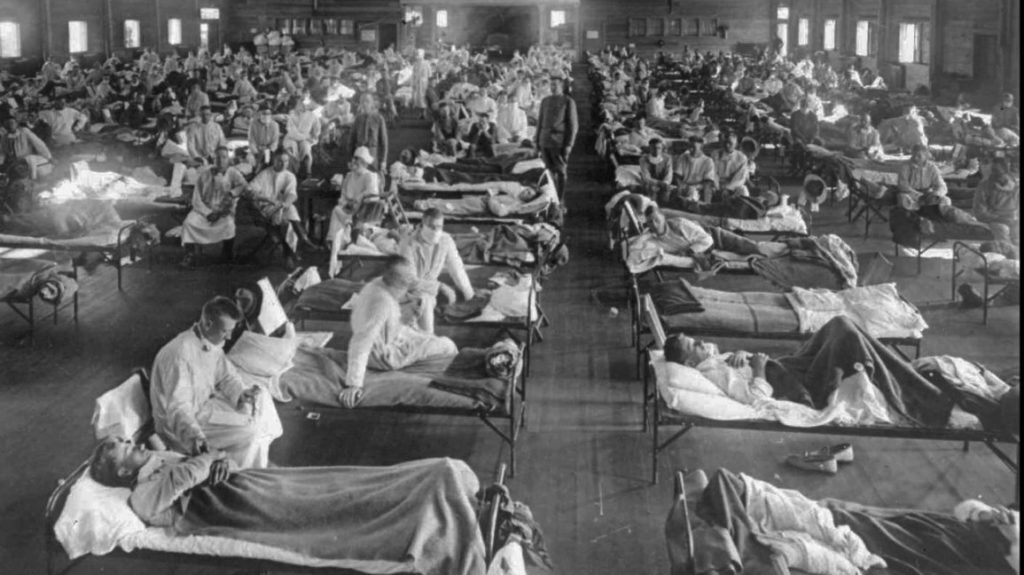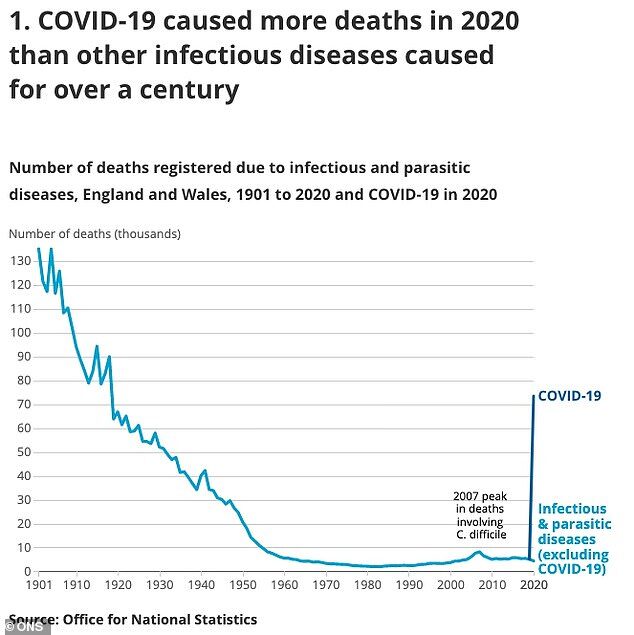Here is the story in the Mail.
The ONS report, entitled "Coronavirus: A Year Like No Other", was released to mark the one year anniversary of people in the UK first being told to limit their non-essential contact with others and to stop all unnecessary travel.It's certainly a striking graph, and it produced the fear-inducing headlines it was presumably intended to generate. But is it a sound use of statistics? Not at all. The comparison it's making is completely misleading. Most significantly, those "infectious and parasitic diseases" it is comparing Covid to do not include the various strains of influenza and other respiratory viruses that do the rounds each winter. Which is why the numbers of deaths it shows for each year is so low since the 1960s - just a few thousand each year.
The report confirmed that COVID-19 caused more deaths last year than other infectious diseases caused in any year for more than 100 years.
More than 140,000 people have died in the UK with coronavirus either described as the underlying cause or as a contributory cause on their death certificates.
Some 73,500 people in England and Wales who died in 2020 had COVID-19 registered as the underlying cause of death.
The ONS said coronavirus is "likely to be classed as an infectious and parasitic disease", allowing a comparison with previous deadly outbreaks.
The statistics body said: "This means COVID-19 was the underlying cause of more deaths in 2020 than any other infectious and parasitic diseases had caused in any year since 1918; that year there were just over 89,900 deaths from various infectious and parasitic diseases registered in England and Wales."
The ONS itself records that winter respiratory viruses in England can kill tens of thousands in a season (see table below).
Dr Clare Craig, a Consultant Pathologist and member of HART, told Lockdown Sceptics:
The infectious disease graph is so so wrong. They have omitted all respiratory infections from the numbers including influenza. Where for example are the 1918 flu deaths? They must have some category in their database that they record as "infectious disease" and for some reason they categorise flu under a different heading. Even flu cases that get diagnosed by PHE would have higher numbers than the numbers they've given.It appears that the ONS coding system classifies "certain infectious and parasitic diseases" together under A and B codes and this is what the graph is plotting. ONS anticipates COVID-19 being in B code. Flu, however, is in J code (J09-11), so is not included.
David Livermore, Professor of Medical Microbiology at the University of East Anglia and Lockdown Sceptics contributor, writes:
There is clearly a lot amiss here.What was the ONS thinking producing such a misleading graph and report, knowing full well it would grab lurid headlines and feed the hysteria that has characterised the last 12 months? A clarification should be issued explaining that these deaths from "infectious diseases" do not include tens of thousands of annual deaths from common infectious diseases, not least from influenza and the other winter respiratory viruses to which COVID-19 is most comparable. The report should be withdrawn as a particularly egregious example of the misuse of statistics.
First, the graph indicates infectious disease deaths dip below 10,000 a year around 1950, then as low as 2,000 a year by 1980. Aside from a minor blip attributed to Clostridium difficile around 2006-7 they stay below 5,000 a year until the COVID-19 pandemic, which shows as a massive spike, with 70,000 deaths in 2020.
This cannot be reconciled with annual (bacterial) sepsis deaths of around 50,000 across the UK, meaning around 45,000 in England and Wales. Nor do bad flu years show. For example, PHE indicates 22,000 flu deaths in England and Wales in the winter of 2017/8 but the graph has less than 6,000 total infection deaths in both these years. Similarly, but likewise absent from the graph, there reportedly were around 30,000 UK deaths in the 1968 flu pandemic and at least as many in 1957. The trough of 2,000 annual infection deaths in the 1980s and 90s is scarcely more than were then attributable to AIDS/HIV alone by 1994-5.
In other words, for most of the period shown, the graph wildly underestimates infection deaths. It may be objected that many of these, particularly in the case of bacterial sepsis, are severely-ill people who succumbed to bacteria that would ordinarily be harmless, and that deaths were often "with the pathogen, not due to it". But that is true of many COVID-19 cases too: it is a virus that predominantly kills those with poor underlying health, particularly care home residents and those who catch it whilst sufficiently unwell to have been hospitalised.
Next, the spike for the 1918 flu is remarkably small. Excess infectious disease mortality (i.e., above the falling trend-line) looks to be only 20,000 or so and, even if spread across 1918 and 1919 (the peak was in Oct/Nov 1918) would still only be less than 40,000. This is far below conventional estimates of around 228,000 deaths (a review of total deaths recorded by the ONS suggests an excess spike around 130,000 to 150,000).
The ONS's generation of the present graph has missed any sort of common sense check by a microbiologist or infectious disease specialist. It makes no sense whatsoever to put flu deaths into a totally different category when flu and SARS-CoV-2 are both mRNA respiratory viruses causing deaths (mostly) in the vulnerable.
It is truly distressing that it is plastered across numerous media outlets at face value.
But then, maybe it is a perversely apt way to mark the anniversary of a pandemic, one of whose central features has been the abuse of statistics to drive public panic and induce compliance.






[Link]
[Link]
[Link]